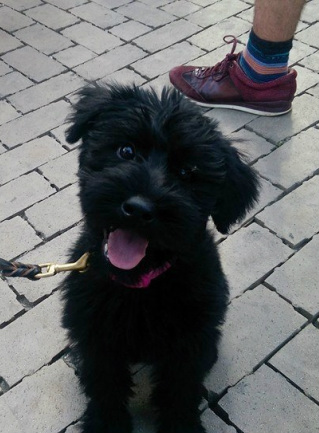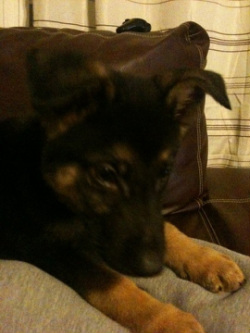 When most people have an interaction with dog trainers they aren't aware that the dog may be working at the time or have a different idea of how you should interact. Generally speaking when people run into me and a dog they will try to interact with the pup. Most people know the general things that will help like crouching or holding their hand out for an inspection but do you know how to maximize your interactions? I wanted to write this to help people who want a better connection with most dogs they meet.
Adam Madore
professional dog trainer with Artisan dog training Lexington / Nicholasville
1 Comment
7/3/2013 3 Comments Socializing your puppy While I was studying to be a dog trainer I learned extensively about socializing dogs. I can't convey the large amount of knowledge here in a short blog post or even in a single lesson. What I will be covering today is summary of some things and a condensed version of others. If your raising a puppy for a certain job you will need to contact me directly or put it on my facebook page. Socializing your dog is generally speaking taking your dog out and exposing him or her to variable scenarios. Introducing new things and experiences in order to amplify your dogs confidence and help them develop without fear of the world around them. Some of you worry about what may happen when you are socializing your puppy. The most common fear is will they come down with some random malady. When your puppy has not finished its round of shots you do have to protect them or they certainly can come down with something possibly fatal. The benefits to your puppy Vastly outweigh the negatives in my eyes because of the amount of control that you can exert over them when they are going somewhere. When a puppy grows from 8 weeks to 12 weeks the puppy isn't really afraid of anything and it would take a rather extreme issue in most puppies minds in order for them to become wary of something. After this short window they will begin to become suspicious of things, people, or other animals. When your choosing places to take your new furry friend remember that they can become overloaded and stressed. If you take them somewhere that is busy or chaotic then they will have a shorter amount of time to take it all in before they need to leave or could become too overloaded and create stress issues. Signs of stress are a puppy licking their lips repeatedly or yawning. More obvious ones like shaking or cowering could present themselves too but don't swoop in right away and evacuate with your puppy just give them a moment to recover. If you are going around other dogs you should be mindful of the other dog and be cautious. Be certain that they do not touch lots of random dogs and puppies. DO NOT TAKE THEM TO DOG PARKS. When you expose a puppy to the dog park they have a Far greater chance to get sick. Many people don't have vaccinations on their dogs or they are not up to date and could harm your puppy. If your puppy is small enough then carrying them around and letting people pet them is a good idea and I be sure to watch my facebook page to find out about things going on in your area that your dog and you would want to do. Adam Madore
professional dog trainer with Artisan dog training Lexington / Nicholasville 4/10/2012 1 Comment Teaching your puppy not to biteTeaching a puppy can be very different from teaching a dog in many ways. Puppies have a very limited viewpoint and need to be taught to discern right from wrong. We love to play with our puppies but a puppy wants to play with us as it will with other puppies. The most prevalent ways to stop this behavior will be laid out in this article. First and foremost is to let your puppy know that biting is not ok and will not achieve positive results. When the puppy bites you can yelp loudly and jerk your hand away. Another way is to grab the puppies lower jaw under his tongue and with your pointer finger and hold for a few seconds. The puppy will pull back and then you let him go. Continue as necessary. The third and final way is with positive reinforcement. You can place a toy between you and the puppy, which allows him a reward and something else to chew on. If he is teething use ice. You may also reward him in your treat training for not biting. Depending on the customer or the puppy these are my usual methods. Except method two, it is rarely called for or needed. Thank you for your time and as always feel free to contact me with any questions. Adam Madore
professional dog trainer with Artisan dog training Lexington / Nicholasville 3/13/2012 1 Comment Puppy socialization trainingThe most important thing to remember when you socialize a puppy is that everything is new. You have to start with the least amount of stress and build on it. If you are expecting your dog to compete or hunt you should take them out around these environments just like anything else. I usually start with myself and my car since these are my puppies first interactions with me. I start in a quiet room when I pick them up and have treats on hand,I patiently let the puppy check me out or just roam around a little while I wait. After they are comfortable with my presence I will make sure the puppy follows me well and head outside. I let them go potty and take them to the car. If she is not interested in it I open the door and shut it a few times so the sound isn't so startling. I put him inside and let him roam around before placing him in the crate.If I have a long way to go I stop frequently to check on the puppy and let them out a little. The first car ride is a good example for you to see how an everyday occurrence needs to be broken down. This will be the same for your yard, house, other dogs, and,cats. If the puppy seems frightened and you don't see a reason for it (ie pulling on a leash and crying loudly when they first see an automatic door) just wait for a minute and take off the slack. Don't pick them up or try to reassure them it will only hurt their growth. When introducing a puppy to a new dog you must have control of the situation and trust in the other dog. If the other dog shows aggression just pull your puppy away quietly, no fuss. Generally puppies can handle their own with puppies their size but be sure to break up any spat without coddling. I'm going to leave off here because I could write a chapter on this but if you have any questions don't hesitate to write me an e-mail or call. Adam Madore
professional dog trainer with Artisan dog training Lexington / Nicholasville |
AuthorAdam Madore is a dog trainer with a passion for training and dogs in general. Archives
July 2014
CategoriesAll Aggressive Dogs Anxiety Chewing Contest Dog Training Drawing Faq Feeding Food Free General Obedience General Tips Gift Card Potty Training Puppy Seperation Socialization |
Search by typing & pressing enter


 RSS Feed
RSS Feed
